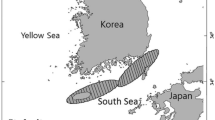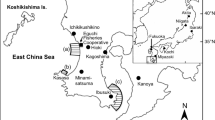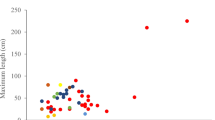Abstract
The temperate seabass Lateolabrax japonicus is a coastal and partial amphidromous fish that is commercially valuable in Japan. Fish age is an important and sensitive variable for stock structure assessment, and inaccurate aging can result in inappropriate management practices. However, there have been few studies on age determination in this species. By examining monthly changes in marginal increment growth, we validated that otolith increments are formed annually. This information was used to develop an age-determination method using otolith sections. Von Bertalanffy growth models were generated based on standard length and weight data for both sexes in Sendai Bay and Tango Bay, Japan. Differences in standard length- and weight-at-age and growth parameters were observed in both sexes and locations. Females exhibited larger standard lengths and weights at older ages than did males, in both locations. Individuals from Sendai Bay exhibited longer average asymptotic lengths, higher asymptotic weight, higher standard length-at-age and higher weight-at-age compared to their counterparts from Tango Bay. Decreases in growth rates in both Sendai Bay and Tango Bay occurred around the age at maturity, indicating that more energy was allocated to reproduction than growth after reaching maturation. Differences between Sendai Bay and Tango Bay in the age at which the maximum instantaneous growth rate and the asymptotic length are reached were thought to arise from differences in water temperature and biological productivity between the two bays.











Similar content being viewed by others
Change history
02 January 2019
In the original publication, Fig. 1 and legend have been incorrectly published. The correct version of Fig. 1 and legend are provided in this Correction.
References
Aho K, Derryberry D, Peterson T (2014) Model selection for ecologists: the worldviews of AIC and BIC. Ecology 95:631–636
Akiyama S (2016) Study on the population dynamics of the mysid Orientomysis japonica in the sandy coastal areas. PhD dissertation, Kyoto University, Kyoto (in Japanese)
Akiyama S, Ueno M, Yamashita Y (2015) Population dynamics and reproductive biology of the mysid Orientomysis japonica in Tango Bay, Japan. Plankton Benthos Res 10:121–131
Bartlett MS (1937) Properties of sufficiency and statistical tests. Proc R Soc London Ser A-Math Phys Eng Sci 160:268–282
Baty F, Ritz C, Charles S, Brutsche M, Flandrois JP, Delignette-Muller ML (2015) A Toolbox for Nonlinear Regression in R: the Package nlstools. J Stat Softw 66:1–21
Cailliet GM, Smith WD, Mollet HF, Goldman JK (2006) Age and growth studies of chondrichthyan fishes: the need for consistency in terminology, verification, validation, and growth function fitting. Environ Biol Fishes 77:211–228
Clark FN (1928) The weight–length relationship of the California sardine (Sardina caerulea) at San Pedro. California State Print Office, USA
Coelho R, Bentes L, Correia C, Gonçalves J, Lino P, Monteiro P, Ribeiro J, Erzini K (2010) Life history of the common Pandora, Pagellus erythrinus (Linnaeus, 1758) (Actinopterygii: Sparidae) from southern Portugal. Braz J Oceanogr 58:233–245
Dunn OJ (1964) Multiple comparisons using rank sums. Technometrics 6:241–252
Erickson CM (1983) Age determination of Manitoban walleyes using otoliths, dorsal spines, and scales. North Am J Fish Manage 3:176–181
Froese R (2006) Cube law, condition factor and weight-length relationships: history, meta-analysis and recommendations. J Appl Ichthyol 22:241–253
Fuji T, Kasai A, Suzuki KW, Ueno M, Yamashita Y (2010) Freshwater migration and feeding habits of juvenile temperate seabass Lateolabrax japonicus in the stratified Yura River estuary, the Sea of Japan. Fish Sci 76:643–652
Fuji T, Kasai A, Ueno M, Yamashita Y (2016) Importance of estuarine nursery areas for the adult population of the temperate seabass Lateolabrax japonicus, as revealed by otolith Sr: Ca ratios. Fish Oceanogr 25:448–456
Fushimi H (2001) Production of juvenile marine finfish for stock enhancement in Japan. Aquaculture 200:33–53
Hansen DJ (1969) Food, growth, migration, reproduction, and abundance of pinfish, Lagodon rhomboides, and Atlantic croaker, Micropogon undulatus, near Pensacola, Florida, 1963–65. Fish bull (Wash DC) 68:135–146
Hatanaka M, Sekino K (1962) Ecological studies on the Japanese sea-bass, Lateolabrax japonicus-II Growth. Nippon Suisan Gakkaishi 28:857 (in Japanese with English abstract)
Hayashi I (1971) On the process of the testicular maturation of the Japanese sea bass, Lateolabrax japonicus. Jpn J Ichthyol 18:39–50 (in Japanese with English abstract)
Hayashi I (1972) On the ovarian maturation of the Japanese sea bass, Lateolabrax japonicus. Jpn J Ichthyol 19:243–254
Hayashi B, Kiyono S (1978) Ecological studies on the Japanese sea bass, in the Western Wakasa Bay: the food habitat and growth of Japanese sea bass in yearling. Bulletin of the Kyoto Institute of Oceanic and Fishery Science 2:109–116 (in Japanese)
Herbst SJ, Marsden JE (2011) Comparison of precision and bias of scale, fin ray, and otolith age estimates for lake whitefish (Coregonus clupeaformis) in Lake Champlain. J Great Lakes Res 37:386–389
Hibino M, Ohta T, Kinoshita I, Tanaka M (2002) Fish larvae and juveniles occurring in the littoral zone of a tidal flat, in the bottom of Ariake Bay. Jpn J Ichthyol 49:109–120
Hibino M, Ohta T, Isoda T, Nakayama K, Tanaka M (2006) Diel and tidal changes in the distribution and feeding habits of Japanese temperate bass Lateolabrax japonicus juveniles in the surf zone of Ariake Bay. Ichthyol Res 53:129–136
Hibino M, Ohta T, Isoda T, Nakayama K, Tanaka M (2007) Distribution of Japanese temperate bass, Lateolabrax japonicus, eggs and pelagic larvae in Ariake Bay. Ichthol Res 54:367–373
Horiki N (1993) Distribution patterns of sea bass Lateolabrax japonicus eggs and greenling Hexagrammos otakii larvae in relation to water masses in the Kii Channel and adjacent waters in winter. Nippon Suisan Gakkaishi 59:201–207 (in Japanese with English abstract)
Ishikawa T, Tachihara K (2008) Age, growth and maturation of the redbelly tilapia Tilapia zillii introduced into the Haebaru Reservoir on Okinawajima Island. Fish Sci 74:527–532
Islam MS, Tanaka M (2006) Spatial variability in the nursery function along a temperate estuarine gradient: role of detrital versus algal trophic pathway. Can J Fish Aquat Sci 63:1848–1864
Islam MS, Ueno M, Yamashita Y (2009) Otolith microstructure of Japanese sea bass larvae and juveniles: description, interpretation and usage for ageing. J Appl Ichthyol 25:423–427
Islam MS, Suzuki WK, Yamashita Y (2010) Selective mortality of larval Japanese seabass in Ariake Bay, Japan. Aquat Ecol 44:309–316
Kasai A, Kurikawa Y, Ueno M, Robert D, Yamashita Y (2010) Salt-wedge intrusion of seawater and its implication for phytoplankton dynamics in the Yura Estuary, Japan. Estuar Coast Shelf Sci 86:408–414
Kasai A, Fuji T, Suzuki KW, Yamashita Y (2018) Partial migration of juvenile temperate seabass Lateolabrax japonicus: a versatile survival strategy. Fish Sci 84:153–162
Keys AB (1928) The weight-length relation in fishes. Proc Natl Acad Sci 14:922–925
Kimura H (1995) Preliminary study on the age determination of Japanese Sea bass, Lateolabrax japonicus by measuring some characteristics of the scales. Bulletin of Yamaguchi Prefecture Naikai Fisheries Experimental Station 24:6–12 (in Japanese)
Kosaka M (1969) Ecology of the common sea bass, Lateolabrax japonicus in Sendai Bay. J Coll Mar Sci Technol Tokai Univ 3:67–85 (in Japanese with English abstract)
Kozlowski J, Czarnolęski M, Dańko M (2004) Can optimal resource allocation models explain why ectotherms grow larger in cold? Integr Comp Biol 44:480–493
Kruskal WH, Wallis WA (1952) Use of ranks in one-criterion variance analysis. J Am Stat Assoc 47:583–621
Kulbicki M, Guillemot N, Amand M (2005) A general approach to length-weight relationships for New Caledonian lagoon fishes. Cybium 29:235–252
Kuwatani Y (1963) The comprehensive study for fish banks related to the ecology of temperate seabass. PhD dissertation, Kyoto University, Kyoto (in Japanese)
Le Cren ED (1951) The length-weight relationship and seasonal cycle in gonad weight and condition in the perch (Perca fluviatilis). J Anim Ecol 20(2):201–219
Lester NP, Shuter BJ, Abrams PA (2004) Interpreting the von Bertalanffy model of somatic growth in fishes: the cost of reproduction. Proc R Soc Lond Ser B-Biol Sci 271:1625–1631
MAFF-Ministry of Agriculture, Forestry and Fisheries of Japan. (1955-2015) Annual report on fishery and aquaculture production statistics, Japan (in Japanese)
Mann RHK (1971) The populations, growth and production of fish in four small streams in southern England. J Anim Ecol 40(1):155–190
Mann HB, Whitney DR (1947) On a test of whether one of two random variables is stochastically larger than the other. Ann Math Stat 18:50–60
Nakabo T (2013) Fishes of Japan: with pictorial keys to the species, vol 3. Tokai University Press, Tokai (in Japanese)
Neilson JD (1984) Effects of feeding regimes and diel temperature cycles on otolith increment formation in juvenile Chinook salmon, Oncorhynchus tshawytscha. Fish Bull (Wash DC) 83:91–101
Nip THM, Ho WY, Wong CK (2003) Feeding ecology of larval and juvenile black seabream (Acanthopagrus schlegeli) and Japanese seaperch (Lateolabrax japonicus) in Tolo Harbour. Hong Kong Environ Biol Fish 66:197–209
Ochiai A, Tanaka M (1998) Ichthyology (new version), Part 2. Koseishakoseikaku, Tokyo, pp 675–691
Ogle D (2013) http://derekogle.com/fishR/examples/oldFishRVignettes/VonBertalanffy.pdf. Accessed 16 Oct 2018
Ogle DH (2018) FSA: Fisheries Stock Analysis. R package version 0.8.19
Ohmi H (2002) Juvenile ecology in Yura River estuary in Wakasa Bay. In: Tanaka M, Kinoshita I (eds) Temperate bass and biodiversity. Koseisha-Koseikaku, Tokyo, pp 44–53 (in Japanese)
Omweri JO, Suzuki KW, Lavergne E, Yokoyama H, Yamashita Y (2018) Seasonality and occurrence of the dominant mysid Neomysis awatschensis (Brandt, 1851) in the Yura River estuary, central Sea of Japan. Estuar Coast Shelf Sci 211:188–198
Ozaki M, Shoji N (2001) Estimates of the total volume of Japaness seabass caught by recreational party boats in Kyoto Bay. Bulletin of Chiba Prefecture Fisheries Experimental Station 57:173–179 (in Japanese)
Panfili J, de Pontual H, Troadec H, Wright P (2002) Manual of fish schlerochronology. Ifremer-IRD coedition, Brest, pp 43–48
Perotto D, Cue RI, Lee AJ (1992) Comparison of nonlinear functions for describing the growth curve of three genotypes of dairy cattle. Can J Anim Sci 72:773–782
Pikitch E, Santora C, Babcock EA, Bakun A, Bonfil R, Conover DO, Houde ED (2004) Ecosystem-based fishery management. Science 305:346–347
Quinn TJ, Deriso RB (1999) Quantitative fish dynamics. Oxford University Press, Oxford
R Core Team (2018) https://www.r-project.org/. Accessed 16 Oct 2018
Robertson DR, Ackerman JL, Choat JH, Posada JM, Pitt J (2005) Ocean surgeonfish Acanthurus bahianus. I. The geography of demography. Mar Eco Prog Ser 295:229–244
Roff DA, Heibo E, Vøllestad LA (2006) The importance of growth and mortality costs in the evolution of the optimal life history. J Evol Biol 19:1920–1930
Shapiro SS, Wilk MB (1965) An analysis of variance test for normality (complete samples). Biometrika 52:591
Simkiss K (1974) Calcium metabolism of fish in relation to ageing. In: Bagenal TB (ed) The ageing of fish. Unwin Brothers Ltd, Old Woking, Surrey, UK, pp 1–12
Stearns SC (1977) The evolution of life history traits: a critique of the theory and a review of the data. Annu Rev Ecol Syst 8:145–171
Stearns S (1992) The evolution of life histories. Oxford University Press, Kettering
Sun G, Zhu Y, Zhou Z, Chen J (1994) Growth and feeding habits of Japanese seabass Lateolabrax japonicas in the estuary of Yangtze River. J Fish China 18:183–189 (in Chinese with English abstract)
Suzuki KW, Kasai A, Ohta T, Nakayama K, Tanaka M (2008) Migration of Japanese temperate bass Lateolabrax japonicus juveniles within the Chikugo River estuary revealed by δ13C analysis. Mar Ecol Prog Ser 358:245–256
Tomiyama T, Uehara S, Kurita Y (2013) Feeding relationships among fishes in shallow sandy areas in relation to stocking of Japanese flounder. Mar Eco Prog Ser 479:163–175
Volk EC, Wissmar RC, Simenstad CA, Eggars DM (1984) Relationship between otolith microstructure and the growth of juvenile chum salmon (Oncorhynchirs kera) under different prey rations. Can J Fish Aquat Sci 41:126–133
Watanabe T (1965) Ecological distribution of eggs of common sea bass, Lateolabrax japonicus (Cuvier) in Tokyo bay. Nippon Suisan Gakkaishi 31:585–590 (in Japanese with English abstract)
Watanabe K, Kasai A, Fukuzaki K, Ueno M, Yamashita Y (2017) Estuarine circulation-driven entrainment of oceanic nutrients fuels coastal phytoplankton in an open coastal system in Japan. Estuar Coast Shelf Sci 184:126–137
Welch TJ, van den Avyle Michael J, Betsill RK, Driebe EM (1993) Precision and relative accuracy of striped bass age estimates from otoliths, scales, and anal fin rays and spines. North Am J Fish Manage 13:616–620
Worm B, Hilborn R, Baum JK, Branch TA, Collie JS, Costello C, Fogarty MJ, Fulton EA, Hutchings JA, Jennings S, Jensen OP, Lotze HK, Mace PM, McClanahan TR, Minto C, Palumbi SR, Parma AM, Ricard D, Rosenberg AA, Watson R, Zeller D (2009) Rebuilding global fisheries. Science 325:578–585
Yamada H, Tomiyama M, Kuno M, Tsumoto K (2000) Occurrence of larvae and junveniles of Japanese sand lance Ammodytes personatus and other taxa in Ise Bay in winter. Bull Jpn Soc Fish Oceanogr 64:25–35 (in Japanese with English abstract)
Yamashita Y, Tanaka M, Miller JM (2001) Ecophysiology of juvenile flatfish in nursery grounds. J Sea Res 45:205–218
Yasuda H, Koike A (1950) Growth of Japanese Principal Fish-II Lateolabrax japonicus (C and V). Nippon Suisan Gakkaishi 16:256–258 (in Japanese with English abstract)
Yosef T, Casselman J (1995) A procedure for increasing the precision of otolith age determination of tropical fish by differentiating biannual recruitment. Recent developments in fish otolith research, Baruch Institute for Marine Biology and Coastal Research by the University of South Carolina, pp. 247–269
Acknowledgements
This study was partly supported by the Link Again Program of the Nippon Foundation - Kyoto University Joint Project. We also thank MEXT for providing a research scholarship to the first author, the Fisheries Technology Department of Kyoto Prefecture and Miyagi Prefecture for providing water-temperature data for the two study locations, and Y. Kumagai and other graduate students of Kyoto University for their assistance with fish measurements.
Author information
Authors and Affiliations
Corresponding author
Electronic supplementary material
Below is the link to the electronic supplementary material.
Rights and permissions
About this article
Cite this article
Jiang, W., Lavergne, E., Kurita, Y. et al. Age determination and growth pattern of temperate seabass Lateolabrax japonicus in Tango Bay and Sendai Bay, Japan. Fish Sci 85, 81–98 (2019). https://doi.org/10.1007/s12562-018-1271-9
Received:
Accepted:
Published:
Issue Date:
DOI: https://doi.org/10.1007/s12562-018-1271-9




